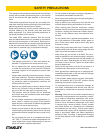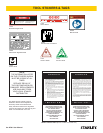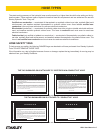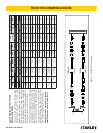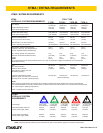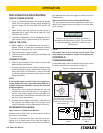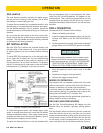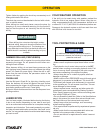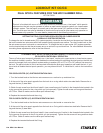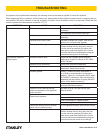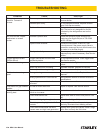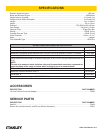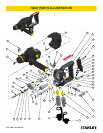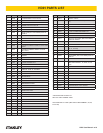
HD01 User Manual ◄ 15
PROBLEM CAUSE SOLUTION
Drill will not start Power not being supplied. Check to make certain that both hoses are
connected.
Turn hydraulic circuit control valve ON.
Defective quick-disconnect. Check each disconnect separately. Replace as
necessary.
Jammed motor and/or parts. Separate modules and inspect. See Service
manual. Do not force parts together.
Flow reversed through hoses. Correct the power source control valve position.
Prevent reverse ow by using only one port
from the valve for pressure, the return tool
hose to the cooler and the lter line. Correct
the quick-disconnect male/female routing per
instructions and arrows on the ttings.
Low hammer impact or
drilling torque.
Incorrect hydraulic ow. Check that the hydraulic power source is
producing 4–9 gpm/15–34 lpm at 750–2000
psi/53–140 bar.
Defective quick-disconnect. Check each disconnect separately.
Worn impact mechanism. Separate modules and repair or replace impact
mechanism. See Service section.
Incorrect grease. DeWALT (forward module) mechanism is
full of uid or contaminants or is improperly
greased. “Clean out, re-lubricate, and/or repair
per DeWALT instructions. See instructions for
separating the rear module to supply DeWALT
portion to the dealer for service”.
Reversing spool incorrectly installed. Reversing spool upside down. Do not separate
modules. See Service section.
Hydraulic circuit relief set too low,
hoses too restrictive or the hydraulic
uid is too thick.
Set relief valve at 2100 psi/145 bar. See
Service section.
Fluid restriction in hose or valve.
Excess back pressure.
Locate and remove restriction.
Use correct uid.
Fluid not warmed-up. Preheat system.
Hoses too long for hose ID. Use shorter hose.
Priority ow control valve or reverse
check valve is malfunctioning.
Do not separate modules. See Service manual.
Flow reversed through hoses. Correct the power source control valve position.
Prevent reverse ow by using only one port
from the valve for pressure, the return tool
hose to the cooler and the lter line. Correct
the quick-disconnect male/female routing per
instructions and the arrows on the ttings.
If symptoms of poor performance develop, the following chart can be used as a guide to correct the problem.
When diagnosing faults in operation of the hammer drill, always check that the hydraulic power source is supplying the cor-
rect hydraulic ow and a pressure to the tool as listed in the table. Use a owmeter known to be accurate. Check the ow
with the hydraulic uid temperature at least 80 °F/27 °C.
TROUBLESHOOTING



